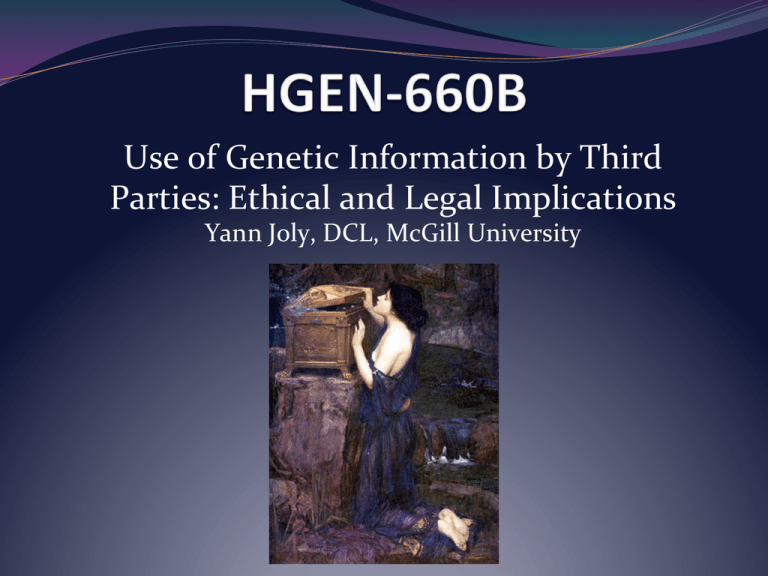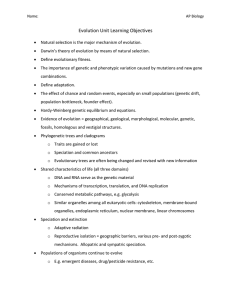Ethical and Legal Implications arising from the use of Genetic Information by Third Parties
advertisement

Use of Genetic Information by Third Parties: Ethical and Legal Implications Yann Joly, DCL, McGill University Medical confidentiality, as it has traditionally been understood by patients and doctors, no longer exists. Mark Siegler (JAMA, 1982) All of the large funding bodies now make data sharing a requirement of support for all projects Kaye et al. (Nature Reviews Genetics, 2009) The limits of confiden0ality An individual can be uniquely identified with access to just 75 single-­‐nucleotide polymorphisms from that person (Zhen Lin et al., 2004). Re-­‐identification of individuals is possible through genotype–phenotype inference and through methods such as genealogical information, trail re-­‐identification or so-­‐ called dictionary attack (Malin et al., 2004). Knowing even some genetic information about an individual could lead to that individual being identified as belonging to the control or affected group within a study (Homer et al., 2008). The limits of confiden0ality Explicit consent (verbal or written) Implicit consent Ordered by the law Expressly authorized by law Gene0c Discrimina0on I belonged to a new underclass, no longer determined by social status or the color of your skin. No, we now have discrimination down to a science. (Gattaca, 1997) Gene0c Discrimina0on: Myth or Reality? Lack of empirical data on genetic discrimination in the context of complex diseases Methodological limits of existing surveys Unverified, self-­‐reported cases of genetic discrimination in several developed countries (UK, US, Australia, Canada, etc.) Gene0c discrimina0on Conflict with the ethical principles of autonomy, equity and dignity A source of anxiety and social stigmatization Could have a negative impact on participation rate in genetic research projects Could prevent people from benefiting from clinically beneficial health interventions (genetic testing) Personal insurance Basic Principles & Beliefs: Private contract Mutuality Utmost good faith Adverse selection UNESCO, Declara'on on the Human Genome (1997) Article 6 No one shall be subjected to discrimination based on genetic characteristics that is intended to infringe or has the effect of infringing human rights, fundamental freedoms and human dignity. Council of Europe, Conven'on on Biomedicine Article 11 – Non-­‐discrimination Any form of discrimination against a person on grounds of his or her genetic heritage is prohibited. Article 12 – Predictive genetic tests Tests which are predictive of genetic diseases or which serve either to identify the subject as a carrier of a gene responsible for a disease or to detect a genetic predisposition or susceptibility to a disease may be performed only for health purposes or for scientific research linked to health purposes, and subject to appropriate genetic counselling. Around the world Europe – Intense legislative activity to prevent insurer’s access to genetic data United States – Legislative patchwork (health insurance discrimination and discrimination in the workplace are generally prohibited, life insurance remains an issue) Asia – Ethical reflection has started in a few countries, no legislative activity Australia, New Zealand, Canada – Substantial debate, no legislative activity See Rothstein and Joly ”, in ATKINSON, P., P. GLASNER & M. LOCK (eds), Property and Privacy, Handbook of Genetics and Society Mapping the New Genomic Era, Routledge, 2008 Discrimina0on in the workplace Genetic screening/genetic monitoring Identify workers having a higher risk of developing certain diseases because of the work environment Detect workers that could pose a risk to the security of other employees or the public Detect job candidates at higher risk of developing specific diseases Identify job candidates who have specific work-­‐ related qualities or traits. Some reported cases UK and US government Sickle Cell screening for air crew applicants US railway worker screening for carpal tunnel syndrom US military screening for glucose 6‑phosphate dehydrogenase (G6PD) Immigra0on To identify applicants that could cause excessive demand on health or social services To confirm biological relationship between family members To confirm a national’s identity in case of doubt Paternity tes0ng DNA testing permit to prove filiation with almost complete certainty (99,8%) Right of the child to know his filiation vs. right of a possible parent to his personal integrity & privacy Using DtC has a proxy for standard legal or consensual process ? Forensic use of DNA Values/rights: Public protection vs. integrity and privacy of convicted individuals Forensic use of DNA DNA typing is universally recognized as the standard against which many other forensic individualization techniques are judged. DNA enjoys this preeminent position because of its reliability and the fact that, absent fraud or an error in labeling or handling, the probabilities of a false positive are quantifiable and often miniscule. Senate of Canada, Public protection, Privacy and the Search for Balance (2010) DNA Data Banks DNA collected from individual suspected of having committed designated offences, or from someone convicted of one of the designated offences Can be kept for a limited amount of time or indefinitely Data protection and IT security Familial Searches Familial searching is a technique whereby a crime scene profile is deliberately run through the offender databank in the hopes of getting a list of profiles that are genetically similar to the DNA evidence and using this information as an investigative lead to interview family members of the near matches. Conclusion “The information that is obtained from the analysis of the 13 DNA markers used for identification purposes can have direct medical relevance.” “[N]o DNA information is truly anonymous, since any portion of the DNA has potential to reveal personal details about an individual.” Testimony of Dr. Martin Somerville, President of the Canadian College of Medical Geneticists, May 2009








